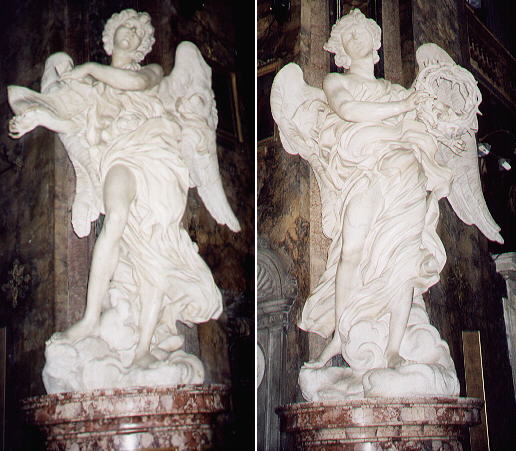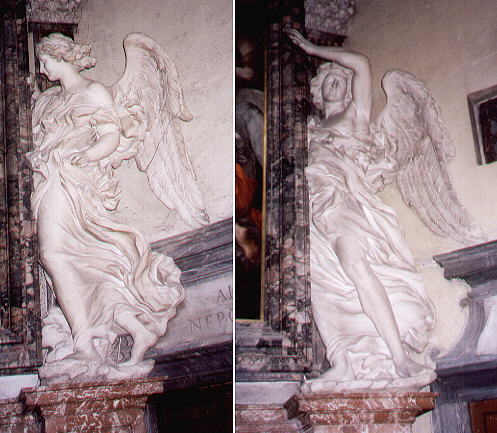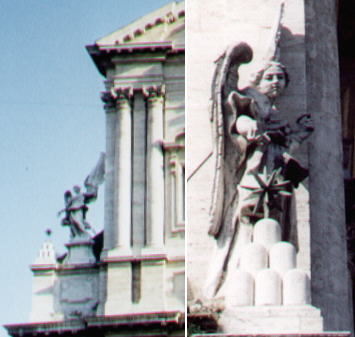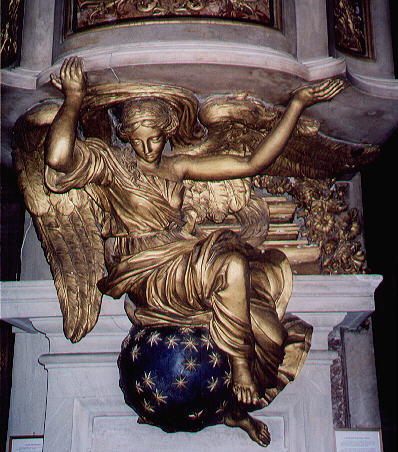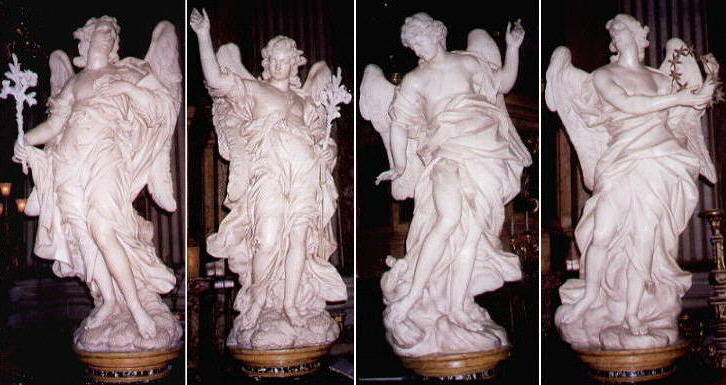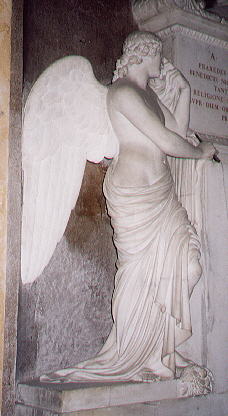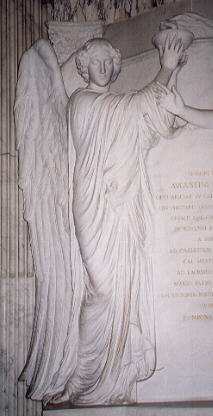  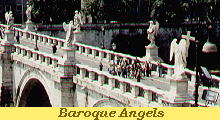 Baroque Angels Baroque Angels
Renaissance artists made large use of putti (naked children especially Cupid-like) (see for an example the balustrade by Mino da Fiesole in the Sistine Chapel) and this tradition was followed also by Baroque artists. Francesco Borromini decorated the minor naves of St John's Lateran with winged heads of children. Gian Lorenzo Bernini showed angels as boys in Habakkuk and the Angel in S. Maria del Popolo and in the Ecstasy of S. Teresa in S. Maria della Vittoria and as children in Cappella Paluzzi Albertoni in S. Francesco a Ripa. However in the XVIIth and XVIIIth centuries angels were more often represented as young men. The most widely known example of this tendency is Ponte S. Angelo where ten statues of angels greet the pilgrims on their way to St Peter's (in the background of this page the angel of Castel S. Angelo by Peter van Verschaeffelt).
Gian Lorenzo Bernini was the author of two of the ten statues: the angel holding the inscription (I. N. R. I.) and the angel holding the crown of thorns.
Pope Clemens IX was so fond of them that he asked Bernini to put on the bridge two copies as he wanted the originals for his own palace.
The statues however remained in Bernini's studio and in 1729 they were donated by Bernini's nephew to the church of S. Andrea delle Fratte (Bernini lived in a palace opposite the church).
In his late works Bernini had a predilection for tall, slender bodies and he used the angels' dresses (and even the clouds) to convey emotions.
The church of S. Maria del Popolo was largely redesigned by Bernini at the request of Pope Alexander VII. The redesign included several statues, which were executed by a team of sculptors. Many of these statues represented angels used as a sort of architectural element. They hold the coat of arms of the pope, the two organs and they show to the viewer the paintings on the altars of the transept. Ercole Ferrata and Antonio Raggi were Bernini's preferred associates.
The use of angels as architectural elements is evident in the fašade of S. Andrea della Valle where they
perform the role usually fulfilled by a volute. The left wing of the angel links the two levels of the fašade.
In the first half of the XVIIIth century the pattern of the angels was slightly modified: they became more effeminate and more naked, with the dress falling in a simpler way and in some cases being so adherent to the body to become transparent. Bernardino Ludovisi and Pietro Bracci worked together in the decoration of Fontana di Trevi and in the altars of the transept of S. Ignazio.
Neoclassicist artists were not very keen to portray angels, a subject thought to be extraneous to the classical world (although Thanatos was often portrayed as an angel: see the relief at the base of Antoninus Pius' column). The wing of the angel (1828) by Giuseppe de Fabris in S. Andrea della Valle does not seem to belong to the Canovian body of the angel. A totally different angel was imagined in 1915 by Adolfo Apolloni for the monument to a member of the Chigi family in S. Maria del Popolo. The very long wing and the hair are a reminiscence of Renaissance paintings.
Other pages dealing with Baroque sculpture: Statues in the act of praying Representation of Death in Baroque sculptures Monuments showing the dead in a medallion Three chapels by Gian Lorenzo Bernini Baroque Monuments to the Popes Three busts by Alessandro Algardi Baroque High Reliefs Statues Close to Heaven Embittered Andrew (the statues in St. Peter's octagon) Laughing Masks Playing with Colours See also my List of Baroque Architects and my Directory of Baroque Sculpture. Go to my Home
Page on Baroque Rome or to my Home Page on Rome
in the footsteps of an XVIIIth century traveller.
|
All images © 1999 - 2003 by Roberto Piperno. Write to romapip@quipo.it
